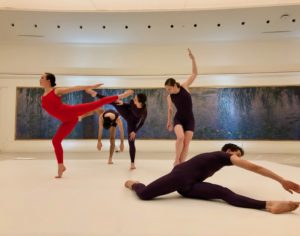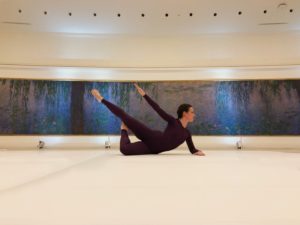Paris, February/March 2020 - Vancouver Ballet Society
- Home
- City Reports 2020 - 2023
- Paris, February/March 2020

By Marisa C. Hayes
The global pandemic, which has closed French theatres indefinitely, delivers an additional economic blow to the Paris Opera Ballet, as it arrives on the heels of the company’s unprecedented winter strike in response to government-proposed retirement reforms. Concurrent performances of Angelin Preljocaj’s Le Parc and Rudolf Nureyev’s Raymonda, as well as annual demonstrations by the Paris Opera’s Ballet School, were all cancelled (save a promising opening night of Raymonda) in December and January, with the strike extending into several more recent performances of Giselle and a mixed Balanchine program.

As a result of the company’s long absence from the stage, anticipation was high for the limited run of Giselle. On February 11, the title character was danced by Dorothée Gilbert, with Mathieu Ganio as Albrecht. A highly-publicized pairing, in reality Ganio’s recent return from injury was premature, notably visible during his second act variations. Gilbert, by contrast, is clearly an étoile at the summit of her career, both technically and theatrically. Her wistful yet determined Giselle in the second act was a refreshingly nuanced performance, traditional in its approach, but never clichéd. While the production is showing its age — it was first adapted by Patrice Bart and Eugène Polyakov in 1991— it remains a solid rendering of Romantic ballet’s apogee performed by a corps de ballet in excellent form.
In late February, the POB strike appeared to be drawing to a close despite the union’s ongoing conflict with the government. The latter offered to maintain the old pension scheme for current employees and artists, reserving the new measures for incoming hires, but the reforms remain heavily contested. With only a few performances of their Balanchine program underway, safety measures in response to the growing pandemic closed opera houses and theatres across the country. This necessary closure is bittersweet after witnessing an accomplished cast perform three staples of the Balanchine repertoire on February 25: Serenade, Concerto Barocco and The Four Temperaments.

Paris Opera Ballet currently boasts a number of dancers who excel in the neoclassical repertoire, including étoile Laura Hecquet, whose infrequent casting since Benjamin Millepied’s departure at the helm of the company continues to disappoint. While her long lines and musical precision have garnered appreciation in other 20th-century works, including last season’s Glass Pieces (Jerome Robbins), Hecquet’s performance in Balanchine’s ethereal Serenade allowed audiences to appreciate a more lyrical side of the dancer. Her fast-paced footwork never lost the breezy touch of Balanchine’s moonlit tribute to Tchaikovsky.
It was Roxane Stojanov, however, who left the deepest impression following her performance in The Four Temperaments, Balanchine’s quintessential leotard ballet. Her captivating solo in the Choleric section possessed elegance, speed and attack, all attributes that were highly prized by the choreographer. Stojanov’s wide-sweeping, bold positions commanded an attentive gaze. It’s no wonder I overheard nearby viewers whispering, “Who was that?” as they rustled to locate her name in the program.
For Paris audiences, the closure of the national dance theatre, Chaillot, is another missed opportunity to see both French and international companies on a weekly basis. The theatre hosted its fourth Biennale d’art Flamenco in January and February. Invited artists included Rocío Molina, Anna Morales and Andrés Marín, all of whom have demonstrated a keen interest in interdisciplinary collaborations with other art forms. This was a consistent feature of the festival, particularly noteworthy in Eva Yerbabuena’s Cuentos de Azúcar (Sugar Tales), which incorporates both Spanish musicians and Anna Sato, who sings traditional music from her native Amami Islands in Japan.

With the notion of time and distance at the heart of this encounter, Cuentos de Azúcar is set within a large circular structure outlined by sculpted metal spirals. It recalls the pataítas of Granada and Seville — a festive form of flamenco in which short danced intervals take place within a collective circle — as well as broader themes of nature and cyclical rites. Yerbabuena’s explosive energy and theatrical flair were punctuated by moments of calm that provided an opening for Sato’s airy vocalizations. The singer created subtle shifts in timing and context, to which the dancer adapted intricate articulations in place, expertly transferring her weight in response to new musical textures.
The ongoing monthly dance series dedicated to diverse short-form performances in Claude Monet’s oval-shaped Nymphéas (Waterlily) galleries at the Musée de l’Orangerie is yet another artistic mainstay impacted by nationwide closures. While the April show by Company Labkine is rescheduled for next season, CCN — Ballet de Lorraine was able to perform a series of Merce Cunningham solos in early March, offering a sample of the works they toured during the Cunningham centennial in 2019.

It is a rare treat to see the Cunningham solos consecutively, but the experience was slightly overshadowed by stationary seating arrangements that encircled the performance. The fixed placement was no doubt a necessary safety measure to protect Monet’s exposed wall panels but lacked the ingenuity of Cunningham’s mid-20th-century museum Events, during which audiences were able to circulate freely.
While some passages of the choreography were easily recognized by Cunningham aficionados, including Summerspace (1958), lesser known solos, such as those from Dime a Dance (1953), were challenging to identify as the repertoire was not cited in the program. Nonetheless, the four versatile CCN — Ballet de Lorraine dancers provided an energetic showing of Cunningham technique, at times nearly leaping off the small dance floor installed in the gallery. Clad in colourful unitards, two women and two men alternated entering and exiting the designated space. As they navigated their way past the seated public, their movements were reminiscent of museum traffic, generating haphazard configurations that surely would have delighted Cunningham for their chance-like potential.

